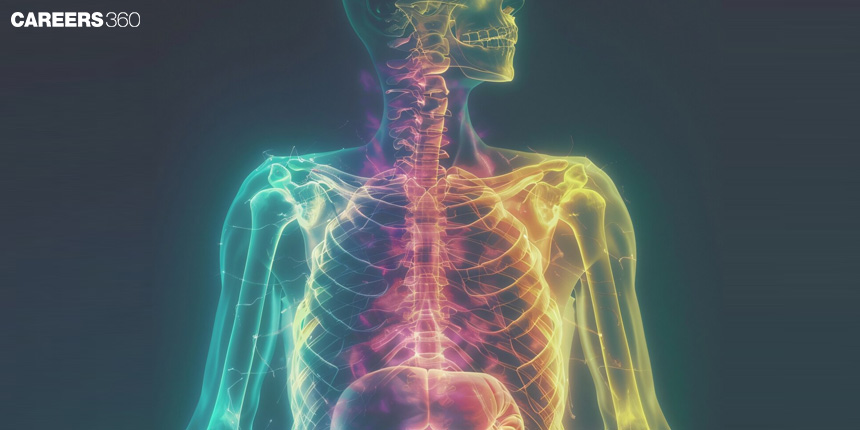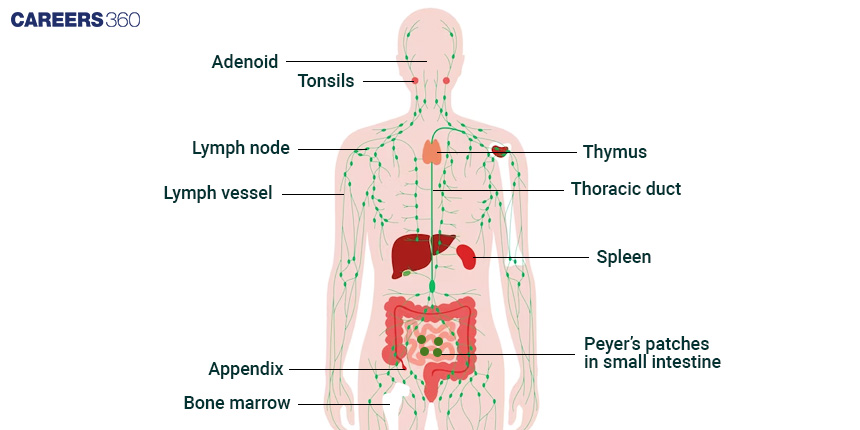Human Lymphatic System: Definition, Diagram, Functions
What Is The Human Lymphatic System?
The human lymphatic system forms part of the immune and circulatory systems of the body. It consists of vessels, nodes, and organs to which it gives one-way circulation—the lymph. It is a transparent fluid containing infection-fighting white blood cells. This system plays either a major or very significant role in maintaining fluid balance, defending against pathogens, and absorbing dietary fats from the gastrointestinal tract.
NEET 2025: Mock Test Series | Syllabus | High Scoring Topics | PYQs
NEET Important PYQ's Subject wise: Physics | Chemistry | Biology
New: Meet Careers360 B.Tech/NEET Experts in your City | Book your Seat now
- What Is The Human Lymphatic System?
- Structure Of The Lymphatic System
- Lymphatic Vessels
- Lymph
- Lymph Nodes
- Primary Lymphoid Organs
- Secondary Lymphoid Organs
- Functions Of The Lymphatic System
- Disorders Of The Lymphatic System
- Lymphatic System and Diseases
- Maintaining A Healthy Lymphatic System
- The Video Recommended On Human Lymphatic System

It becomes important because the lymphatic system is related to both the circulatory and the immune systems. It helps in returning the excess interstitial fluid into the blood circulation, thereby avoiding tissue swelling and maintaining blood volume. Another major function it carries out is the filtering of noxious substances by the lymph nodes which produces and circulates lymphocytes required for immune responses. This interrelation thus makes sure that development from fluids is undertaken effectively and that the body is guarded against various infectious diseases.
Structure Of The Lymphatic System
The lymphatic system is made up of various components that serve unique functions, all of which interplay to achieve the duties of this complex system.
Lymphatic Vessels
Very thin-walled vessels that transport lymph.
They are similar to veins, with more valves to prevent backflow.
They are not blood vessels; they transport lymph, not blood.
They collect and filter the interstitial fluid and return it into the bloodstream.
Lymph
A clear fluid with a high composition of WBCs and mainly with predominant lymphocytes.
It assists in the movement of immune cells and products of waste removal from tissues.
Lymph is similar to Blood plasma but has a lesser amount of proteins and more WBCs.
Blood plasma travels within the blood vessels, and lymph flows through lymphatic vessels.
Lymph Nodes
Small, oval structures that occur along the course of lymphatic vessels
They occur in groups in the neck, armpits and groin area
They filter lymph returning to the bloodstream which traps bacteria, viruses as well as other foreign substances, they contain lymphocytes that mount responses against pathogens.
Primary Lymphoid Organs
These are classified as :
Bone Marrow
Differentiates into all blood cells, including lymphocytes.
Site of B-cyte maturation.
Thymus
An organ in the chest above the heart.
Plays a vital role in developing and maturing T-cells, a type of lymphocyte.
Secondary Lymphoid Organs
These are classified as:
Spleen
Above the left upper abdomen.
It filters the blood, removing old red blood cells, and it helps your body defend against infection.
Tonsils And Adenoids
They are tissues in the throat and nose.
They trap pathogens from food and air.
Peyer's Patches
These are found in the small intestine.
Monitor the bacteria that reside in the intestines and keep the growth of pathogenic bacteria at bay.
Diagram: Human Lymphatic System

Functions Of The Lymphatic System
The lymphatic system performs some very crucial functions, integral to keeping the body in good health.
Fluid Balance
Picks up the excess of interstitial fluid from tissues.
Returns fluid into the bloodstream to avoid oedema.
Lymphatic capillaries pick up fluid from the interstitium.
Transportation of fluid along lymphatic vessels to the lymph nodes where it is emptied into the circulatory system.
Immune System Support
Lymph nodes filter pathogens from lymph.
Infection response of lymphocytes within nodes.
Transport by lymph of lymphocytes to sites of infection.
Allows for interchange and communication between immune cells.
Fat Absorption
Specialised lymphatic capillaries in the intestinal villi.
They absorb dietary fats before passing them into the bloodstream.
Fatty acids and glycerol are absorbed by lacteals.
Absorbed and transported as chyle, a milky fluid, to the thoracic duct and into the bloodstream.
Disorders Of The Lymphatic System
Different disorders may affect the functioning of the Lymphatic System.
Lymphedema
Blockage or damage to lymphatic vessels causes
Symptoms include swelling, pain, limited movement of limbs
Treatment: compression garments, physical therapy, surgery.
Massage for lymphatic drainage to reduce swelling.
Lymphoma
Types: Hodgins and Non-Hodgkins Lymphoma
Hodgkin lymphoma: the presence of Reed Sternberg cells
Non-Hodgkin lymphoma: A heterogeneous group of blood cancers affecting WBCs.
Symptoms: swollen lymph nodes, fatigue, and weight loss
Diagnosis: Biopsy Imaging Blood tests
Infections (Lymphadenitis)
Bacterial, viral, or fungal infection.
Symptoms Swollen, tender lymph nodes Fever and chills.
Antibiotics, antiviral or antifungal medications.
Pain relievers and warm compresses for symptomatic relief.
Lymphatic System and Diseases
Various diseases, especially cancer and HIV, are associated with the lymphatic system.
Lymphatic System In Cancer Metastasis
Cancer cells can leap into lymph vessels to be then transported right to the lymph nodes.
Via the lymphatic system to other parts of the body.
Treatment includes surgery, chemotherapy, and radiation therapy.
HIV And Lymphatic System
HIV attacks and eliminates the CD4+ T-cells in lymph nodes.
Weakens immune systems, making it very hard to repel infections
Antiretroviral Therapy, ART, to control the virus growth.
Primarily, the state of immune function and general health is regularly checked.
Maintaining A Healthy Lymphatic System
The lymphatic system is very crucial to be kept fit. Here are some guidelines on how to keep it healthy.
Nutrition And Diet
Fresh fruits and vegetables
Source of omega-3 fatty acids: fish and flaxseeds
Water intake: the lymph fluid needs water to flow properly.
Prevents lymph from thickening and becoming sluggish.
Exercise/Physical Activity
Physical activity stimulates lymphatic flow.
Regular physical activity prevents lymphatic congestion.
Examples are walking, swimming, yoga, and best of all rebounding, jumping on a mini-trampoline.
Conclusion
It is essential for maintaining fluid balance, supporting immune function, and absorbing dietary fats. Understanding the structure, associated functions, and common disorders of this system allows individuals to take some measures for the health of the lymphatic system—an important factor for perfect health and well-being.
The Video Recommended On Human Lymphatic System
Frequently Asked Questions (FAQs)
The lymphatic system is responsible for maintaining fluid balance, supporting the immune system, and absorbing fats from the digestive tract.
The lymphatic system supports the immune system by filtering through the lymph nodes pathogens and producing lymphocytes that help fight infections.
The common diseases are Lymphedema, Lymphoma, and Lymphadenitis.
Follow a healthy diet, stay well-hydrated, have regular physical activity, and avoid risk factors like smoking or excessive alcohol intake.
Lymph is a clear fluid containing WBCs and some proteins; blood plasma, on the other hand, is the fluid portion of blood containing red and WBCs, platelets, and different proteins.
Also Read
29 Nov'24 01:19 PM
27 Nov'24 07:39 PM
27 Nov'24 07:15 PM
27 Nov'24 05:11 PM
26 Nov'24 08:14 PM
26 Nov'24 06:50 PM
26 Nov'24 05:51 PM
26 Nov'24 04:44 PM
26 Nov'24 03:52 PM
26 Nov'24 02:55 PM

